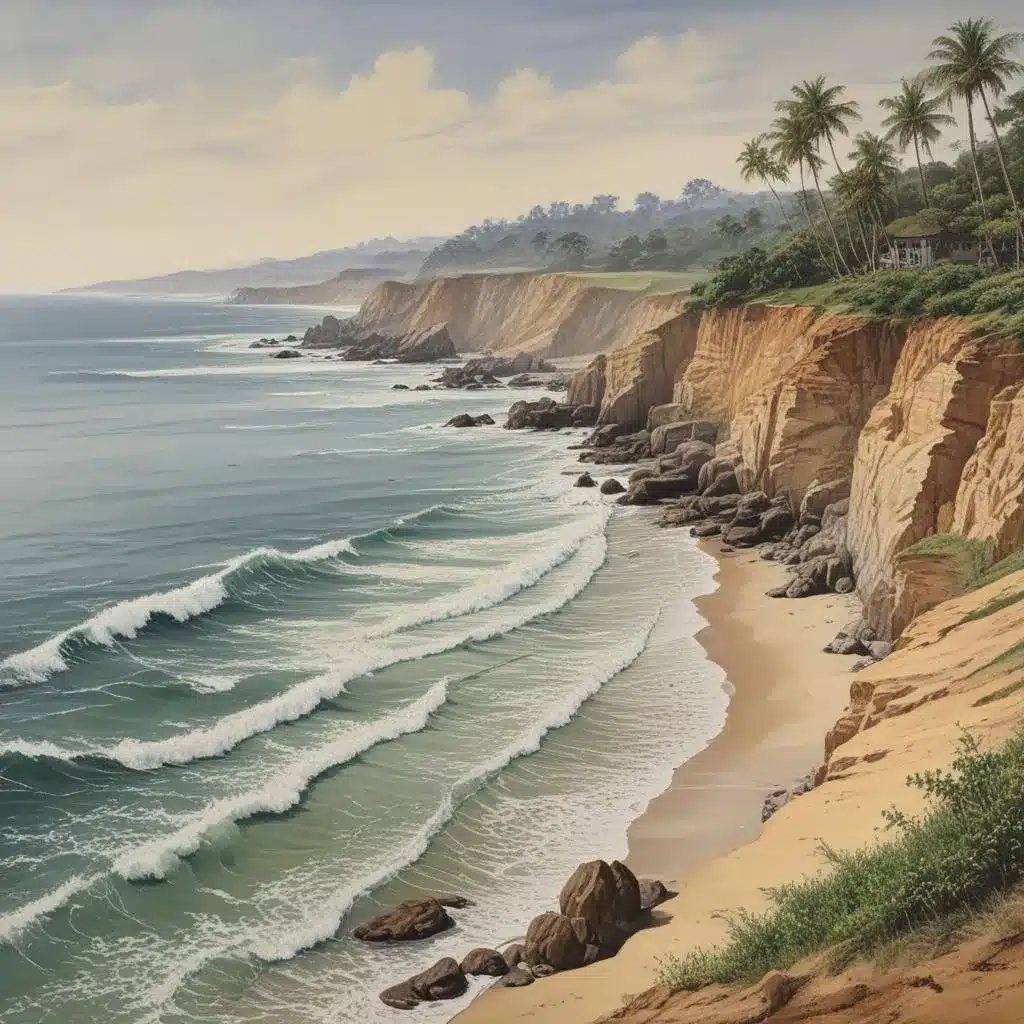
In an era of rapid environmental change, the art of capturing coastal landscapes has taken on a renewed sense of significance and urgency. As rising sea levels and extreme weather events threaten to transform the very nature of our shorelines, the work of artists like V. Chitra stands as a vital record of these precious natural landscapes. Through her detailed pencil drawings and mixed media compositions, Chitra not only celebrates the beauty of coastlines, but also encourages us to consider our role in preserving these fragile ecosystems.
Pencil Drawing Techniques for Coastal Landscapes
At the heart of Chitra’s artistic practice is a mastery of pencil drawing. Her coastal scenes are rendered with an exceptional level of detail, capturing the rugged textures of weathered rock formations, the delicate interplay of sand and water, and the intricate patterns of coastal vegetation. Chitra’s pencil drawing technique involves a patient, layered approach, building up form and texture through a combination of line work, shading, and blending.
She begins by establishing the basic shapes and structures of the landscape using detailed sketching, carefully planning the composition and perspective. Chitra then moves into the rendering stage, utilizing a variety of pencil strokes to convey the unique characteristics of each element – from the sharp, angular lines that define rocky outcrops to the soft, feathery strokes that suggest the movement of grasses and foliage.
Chitra’s mastery of value and tone is particularly evident in her depictions of water, where she masterfully captures the play of light and shadow on the surface of the ocean, lakes, and tidal pools. By alternating between heavy, dark shading and delicate, feathered highlights, she creates a sense of depth and movement that truly brings the water to life.
Capturing the Essence of Coastal Environments
Beyond her technical prowess, Chitra’s drawings are distinguished by her keen eye for the essential details and patterns that define coastal environments. Through close observation and a deep understanding of these natural systems, she is able to distill the very essence of a place onto the page.
“When I’m out in the field, sketching and observing the coastline,” Chitra explains, “I’m not just focused on rendering the surface details. I’m also trying to capture the underlying rhythms and structures that give each landscape its unique character – the way the rocks are weathered and worn, the dynamic interplay of land and sea, the specific flora and fauna that thrive in that particular environment.”
This holistic approach is evident in works like “Coastal Sentinels,” which depicts a row of rugged, wind-swept trees standing guard over a rocky shore. Chitra’s attention to detail is remarkable, from the intricate bark patterns to the subtle variations in foliage, yet the true power of the piece lies in the way it evokes a tangible sense of place and atmosphere.
Similarly, in “Tidal Pools,” Chitra masterfully conveys the ephemeral and transitory nature of these coastal micro-habitats. Through her skillful use of mixed media techniques, incorporating both pencil and watercolor, she creates a sense of fluidity and movement, mirroring the ebb and flow of the tides.
Preserving Coastal Landscapes Through Art
As the impacts of climate change become increasingly evident along our coastlines, Chitra’s work takes on an even greater significance. Her detailed, evocative drawings serve as a vital record of these endangered environments, preserving their beauty and character for future generations.
“In an age where we’re witnessing so much rapid change and loss, I feel a deep responsibility as an artist to document these precious landscapes,” Chitra reflects. “My hope is that my work can inspire a greater appreciation and understanding of the fragile ecosystems that define our coasts, and motivate people to become more actively involved in their protection and preservation.”
Plein Air Painting and the Coastal Landscape
Chitra’s artistic practice is not limited to the studio, however. She is also a passionate plein air painter, venturing out onto the coast to capture the ever-changing moods and conditions of these environments in real-time. This direct, on-site approach allows her to immerse herself in the sensory experience of the landscape, from the play of light on the water to the ebb and flow of the tides.
“There’s something truly magical about painting on location,” Chitra enthuses. “You’re not just rendering a static scene – you’re bearing witness to the constant flux and transformation that defines the coastal experience. The challenge is to translate those dynamic, ephemeral qualities onto the canvas in a way that conveys the essence of the place.”
Chitra’s plein air paintings often feature bold, expressive brushstrokes and a vibrant, dynamic color palette that capture the energy and vitality of the coastline. Works like “Sunset Shores” and “Crashing Waves” showcase her ability to distill the essence of a scene through the strategic application of paint, texture, and composition.
Inspiring the Next Generation of Coastal Artists
Beyond her own artistic practice, Chitra is also deeply committed to nurturing the next generation of coastal artists and landscape painters. She regularly leads drawing and painting workshops for aspiring artists, sharing her techniques and insights, and encouraging participants to develop their own unique perspectives on the natural world.
“I truly believe that art has the power to foster a deeper connection with the environment,” Chitra explains. “When people engage with the coastal landscape through drawing, painting, or other creative mediums, they start to see it in a new light – to truly appreciate its beauty, complexity, and fragility. And that, in turn, can inspire a lifelong commitment to its protection and preservation.”
Through her work, both as a practicing artist and an educator, Chitra is playing a vital role in preserving the art of coastal landscape representation. In an era of unprecedented environmental change, her detailed, evocative drawings and paintings serve as a powerful reminder of the enduring beauty and importance of these precious natural spaces.
Tip: Practice daily sketching to continually refine your technique